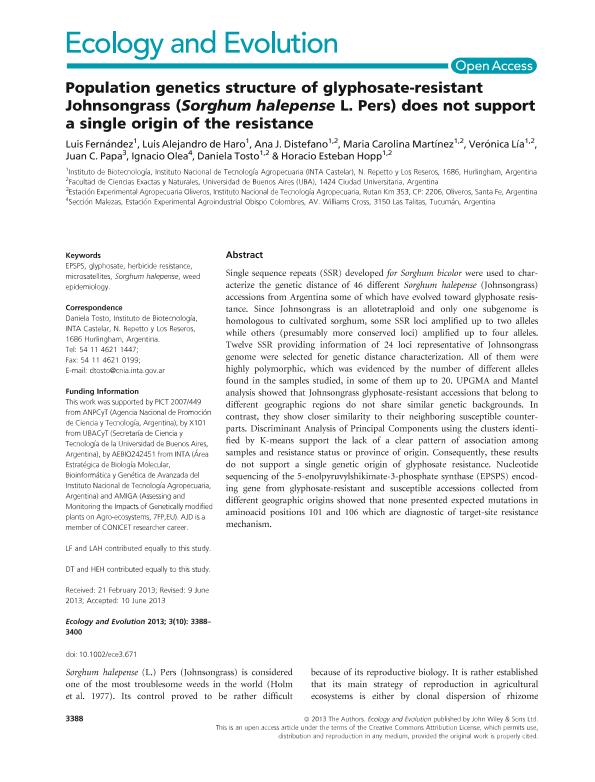Mostrar el registro sencillo del ítem
dc.contributor.author
Fernández, Luis
dc.contributor.author
de Haro, Luis Alejandro

dc.contributor.author
Distefano, Ana J.
dc.contributor.author
Martínez, María Carolina
dc.contributor.author
Lia, Verónica Viviana

dc.contributor.author
Papa, Juan C.
dc.contributor.author
Olea, Ignacio
dc.contributor.author
Tosto, Daniela Sandra

dc.contributor.author
Hopp, Horacio Esteban

dc.date.available
2020-04-28T16:49:38Z
dc.date.issued
2013-09
dc.identifier.citation
Fernández, Luis; de Haro, Luis Alejandro; Distefano, Ana J.; Martínez, María Carolina; Lia, Verónica Viviana; et al.; Population genetics structure of glyphosate-resistant Johnsongrass (Sorghum halepense L. Pers) does not support a single origin of the resistance; Wiley; Ecology and Evolution; 3; 9-2013; 3388-3400
dc.identifier.issn
2045-7758
dc.identifier.uri
http://hdl.handle.net/11336/103789
dc.description.abstract
Single sequence repeats (SSR) developed for Sorghum bicolor were used to characterize the genetic distance of 46 different Sorghum halepense (Johnsongrass) accessions from Argentina some of which have evolved toward glyphosate resistance. Since Johnsongrass is an allotetraploid and only one subgenome is homologous to cultivated sorghum, some SSR loci amplified up to two alleles while others (presumably more conserved loci) amplified up to four alleles. Twelve SSR providing information of 24 loci representative of Johnsongrass genome were selected for genetic distance characterization. All of them were highly polymorphic, which was evidenced by the number of different alleles found in the samples studied, in some of them up to 20. UPGMA and Mantel analysis showed that Johnsongrass glyphosate-resistant accessions that belong to different geographic regions do not share similar genetic backgrounds. In contrast, they show closer similarity to their neighboring susceptible counterparts. Discriminant Analysis of Principal Components using the clusters identified by K-means support the lack of a clear pattern of association among samples and resistance status or province of origin. Consequently, these results do not support a single genetic origin of glyphosate resistance. Nucleotide sequencing of the 5-enolpyruvylshikimate-3-phosphate synthase (EPSPS) encoding gene from glyphosate-resistant and susceptible accessions collected from different geographic origins showed that none presented expected mutations in aminoacid positions 101 and 106 which are diagnostic of target-site resistance mechanism.
dc.format
application/pdf
dc.language.iso
eng
dc.publisher
Wiley

dc.rights
info:eu-repo/semantics/openAccess
dc.rights.uri
https://creativecommons.org/licenses/by-nc/2.5/ar/
dc.subject
MOLECULAR EPIDEMILOGY
dc.subject
SORGHUM HALEPENSE
dc.subject
GLYPHOSATE RESISTANCE
dc.subject
GMO IMPACT IN TARGET SPECIES
dc.subject.classification
Genética y Herencia

dc.subject.classification
Ciencias Biológicas

dc.subject.classification
CIENCIAS NATURALES Y EXACTAS

dc.title
Population genetics structure of glyphosate-resistant Johnsongrass (Sorghum halepense L. Pers) does not support a single origin of the resistance
dc.type
info:eu-repo/semantics/article
dc.type
info:ar-repo/semantics/artículo
dc.type
info:eu-repo/semantics/publishedVersion
dc.date.updated
2020-04-28T14:10:14Z
dc.journal.volume
3
dc.journal.pagination
3388-3400
dc.journal.pais
Estados Unidos

dc.description.fil
Fil: Fernández, Luis. Instituto Nacional de Tecnología Agropecuaria. Centro de Investigación en Ciencias Veterinarias y Agronómicas. Instituto de Biotecnología; Argentina
dc.description.fil
Fil: de Haro, Luis Alejandro. Consejo Nacional de Investigaciones Científicas y Técnicas; Argentina. Instituto Nacional de Tecnología Agropecuaria. Centro de Investigación en Ciencias Veterinarias y Agronómicas. Instituto de Biotecnología; Argentina
dc.description.fil
Fil: Distefano, Ana J.. Universidad de Buenos Aires. Facultad de Ciencias Exactas y Naturales. Departamento de Fisiología, Biología Molecular y Celular. Laboratorio de Agrobiotecnología; Argentina. Instituto Nacional de Tecnología Agropecuaria. Centro de Investigación en Ciencias Veterinarias y Agronómicas. Instituto de Biotecnología; Argentina
dc.description.fil
Fil: Martínez, María Carolina. Instituto Nacional de Tecnología Agropecuaria. Centro de Investigación en Ciencias Veterinarias y Agronómicas. Instituto de Biotecnología; Argentina. Universidad de Buenos Aires. Facultad de Ciencias Exactas y Naturales. Departamento de Fisiología, Biología Molecular y Celular. Laboratorio de Agrobiotecnología; Argentina
dc.description.fil
Fil: Lia, Verónica Viviana. Consejo Nacional de Investigaciones Científicas y Técnicas; Argentina. Instituto Nacional de Tecnología Agropecuaria. Centro de Investigación en Ciencias Veterinarias y Agronómicas. Instituto de Biotecnología; Argentina. Universidad de Buenos Aires. Facultad de Ciencias Exactas y Naturales. Departamento de Fisiología, Biología Molecular y Celular. Laboratorio de Agrobiotecnología; Argentina
dc.description.fil
Fil: Papa, Juan C.. Instituto Nacional de Tecnologia Agropecuaria. Centro Regional Santa Fe. Estacion Experimental Agropecuaria Oliveros. Agencia de Extension Rural Arroyo Seco.; Argentina
dc.description.fil
Fil: Olea, Ignacio. Gobierno de Tucumán. Ministerio de Desarrollo Productivo. Estación Experimental Agroindustrial Obispo Colombres; Argentina
dc.description.fil
Fil: Tosto, Daniela Sandra. Consejo Nacional de Investigaciones Científicas y Técnicas; Argentina. Instituto Nacional de Tecnología Agropecuaria. Centro de Investigación en Ciencias Veterinarias y Agronómicas. Instituto de Biotecnología; Argentina. Universidad de Buenos Aires. Facultad de Ciencias Exactas y Naturales. Departamento de Fisiología, Biología Molecular y Celular. Laboratorio de Agrobiotecnología; Argentina
dc.description.fil
Fil: Hopp, Horacio Esteban. Instituto Nacional de Tecnología Agropecuaria. Centro de Investigación en Ciencias Veterinarias y Agronómicas. Instituto de Biotecnología; Argentina. Universidad de Buenos Aires. Facultad de Ciencias Exactas y Naturales. Departamento de Fisiología, Biología Molecular y Celular. Laboratorio de Agrobiotecnología; Argentina
dc.journal.title
Ecology and Evolution
dc.relation.alternativeid
info:eu-repo/semantics/altIdentifier/url/http://onlinelibrary.wiley.com/doi/10.1002/ece3.671/pdf
dc.relation.alternativeid
info:eu-repo/semantics/altIdentifier/doi/http://dx.doi.org/10.1002/ece3.671
Archivos asociados
